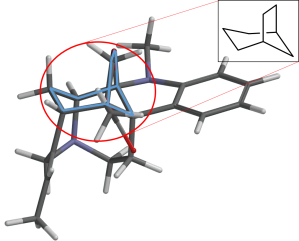I had an exchange with @fluorogrol today talking about poorly thought out chemical structures. It began when the pseudonymous blogger tweeted out the (less than optimal) structure of this alkaloid:
https://twitter.com/fluorogrol/status/624502494966771712
Wrong, indeed. Representing complex stereochemistry can be quite tricky. But bonds extending halfway across the molecule is generally not the way to go. Chemical structures must satisfy two requirements: 1) they must be unambiguous, and 2) they must accurately represent the 3-dimensional shape of the the actual molecule. I responded with my take:
…which was straightened out and rotated a bit, giving us this final, unambiguous structure:
https://twitter.com/fluorogrol/status/624589642663227392
No exaggerated bonds, no stereocenters consisting of a cluster of wedges. Plus, now you can quickly get an idea for the actual shape of the molecule. Now, admittedly, I have no idea where the original structure appeared, but I’m going to assume it’s from a publication. Which means a group of scientists, and presumably at least one organic chemist, collectively decided that structure was the best way to represent akuammine (the wikipedia page structure is equally bad).
And to think, this tragedy could have been easily avoided. Here’s a quick checklist on how to draw an accurate, sexy structure of your molecule.
1) Does the molecule have any cyclic or bicyclic motifs common in organic chemistry?
If yes, start there. These structures are so ubiquitous in organic chemistry that they give readers a quick and easy 3-D reference point. Not sure if there’s one of these in your molecule? Proceed to step 2.
2) Load you molecule up in the three-dimensional molecule viewer of your choice. The professional edition of ChemDraw comes with Chem3D, which will do the trick. As will whatever you may use for energy calculations. Don’t have access to any 3D chemistry software? MolView has you covered with its in-browser tool, which can even perform simple energy minimization calculations.
Rotate the structure around a bit. Look for any of the aforementioned motifs.
Still can’t find one? Then…
3) Find and angle from which all atoms are more or less visible. Of course, your ChemDraw structure doesn’t need to perfectly match all bond angles and distances, but try to replicate them as faithfully as possible. A good angle is one from which stereochemistry is unambiguous and doesn’t require dashes and wedges everywhere to makes sense of the structure. Also, don’t forget the ever underutilized “structure perspective” tool in ChemDraw; make judicious use of it.
Maybe I’ll start featuring a “bad structure of the week” here.


